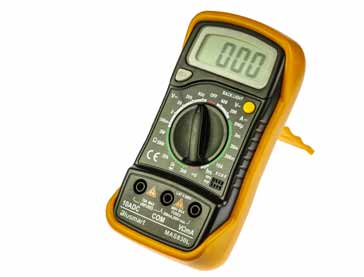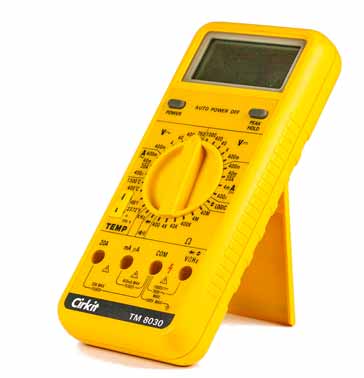Cheap vs Expensive Digital Multimeter
Do you buy a cheap digital multimeter, or an expensive one as the cheap ones offer very good levels of performance for a low cost so do the expensive ones offer value for money.
Multimeter Tutorial Includes:
Test meter basics
Analogue multimeter
How does an analogue multimeter work
DMM digital multimeter
How a DMM works
DMM accuracy & resolution
DMM CAT ratings
How to buy best digital multimeter
Cheap vs expensive DMM
How to use a multimeter
Voltage measurement
Current measurements
Resistance measurements
Diode & transistor test
Fault finding transistor circuits
Analogue vs Digital multimeter
Test leads & probes
When buying a digital multimeter there can be a real debate about how much to spend in this type of test instrument: the cheap vs expensive multimeter.
On the one hand it is possible to buy a reasonable DMM for very little cost, and what's the benefit of buying an expensive one.
There can be a factor of 10:1 difference between buying a high end and low end multimeter.
As a result, it is worth investigating exactly what the differences are and whether it is worth paying all the difference for a high end digital multimeter.
Advantages of the low cost meter
It's worth taking a look at the advantages of a low cost multimeter first, as this is the option many people might opt for.

These meters can offer a variety of capabilities, and advantages often around the level indicated in the list below.
Cost: This is the fundamental advantage of the many low cost multimeters that can be obtained.
Measurement capabilities & ranges: Despite their low cost, these meters still offer a good number of capabilities. Typical ranges include:
- DC volts: a few ranges with a maximum of often around 500V
- AC volts: up to 500V or so but possibly no low volts ranges.
- DC current: often ranging from around 1mA, or so to a few amps - no AC current is available on many low cost DMMs
- AC current: there is often no AC current range.
- Ohms ranges: often between about 200 to 20MΩ maximum.
- Buzzer continuity function: is also common place.
- There may also be a just few other capabilities, including diode test, transistor hfe, etc.
Display: This might have something like 3½ digits or 2000 counts
Accuracy: Although not at all bad, the accuracy of the readings might be around ±0.8% on the volts ranges and possibly ±1.2% for the current ranges and possibly ± 0.8% to 1.2% for the ohms ranges rising to ±2% for readings on a 200MΩ range. All of these are likely to be +2D (digits)
Safety rating: Many digital multimeters have a safety rating on them. Higher cost ones may be CAT III or CAT IV, but the low cost ones are likely to be CAT II indicating they are really only suitable for low voltage and some mains / line work on pluggable items only, i.e. not for electrical installations.
Reliability: The reliability of the low cost ones is not not expected to be as good as that of the high end ones. However, this is often not an issue for occasional or less arduous usage.
This is all very good, and these low cost digital multimeters do very well, but how do they compare to the higher cost ones.
But smal issues might arise - the yellow shock absorbent surround on one of mine started to deteriorate after a very few years leaving a yellow slime on the worktop, etc. It also started to degrade the plastic of the main body case of the meter. Cleaned up it was not too bad, but a warning of some of the issues that might happen.
Advantages of higher cost multimeters
The more expensive meters will naturally offer better performance and more ranges, etc.

There is a considerable variety in what more expensive meters offer. Some may have what might be considered a fairly limited
Cost: This is likely to be very much higher than the low cost DMM, possibly 10 - 20 times as much.
Measurement capabilities & ranges: The higher cost is likely in many cases to be reflected in the availability of more ranges. Typical ranges include:
- DC volts: typical ranges might be 600.00mV to 1000.0V
- AC volts: typical ranges might be 600.00mV to 1000.0V with a frequency limit of 100kHz or more. Ofte these will be true RMS.
- DC current: typical ranges might be from 600.00µA to 10.000A
- AC current: typical ranges might be from 600.00µA to 10.000A with a frequency limit of 100kHz or more, often true RMS.
- Ohms ranges: a typical higher cost DMM may have maxima for the ranges of 600.00Ω to 60.000MΩ
- Capacitance: this is a common range on many DMMs and ranges may be for 10.00nF to 10.00µF
- Frequency: Some DMMs will have a limited frequency measurement capability, often limited to around 1MHz or so, but useful nevertheless.
- Temperature: There is often the capability for temperature measurements by using en external thermocouple.
- Buzzer continuity function: is also common.
- There may also be several other capabilities dependent upon the particular meter.
Additional features: Many high end DMMs will have some useful additional features including auto ranging, auto-shut-off, peak capture, true RMS, etc.
Fused current ranges: Most high end DMMs with have fuses to protect the high current ranges because it is easy to overload these by accidentally placing them across a supply rather than in series.
Display: This might have something 5000 counts or more - some may have 60000
Accuracy: This will be considerably better than the low cost DMMs - meters might often have an accuracy of ± 0.03% +2d
Safety rating: These higher cost DMMs are most likely to be CAT III or CAT IV, and with higher surge voltage test accreditation making them suitable for use on many electrical installations.
Reliability: One of the key features of high end DMMs is that they will offer a higher level of reliability than the low cost ones. Many people report that DMMs from well established companies function reliably over very many years.
The more costly multimeters will offer much more in terms of measurement capabilities (although some focus on the basic measurements, but providing accuracy, robustness and reliability) and we as providing better displays, better reliability, greater accuracy and more.
It can be seen the even though the low cost DMMs offer really excellent value for money, they are now able to compete with the higher cost ones on almsot every factor.
However, they can stil provide really excellent service, especially if the additional features of the high end DMMs are not required. If these additional ranges, features, safety, reliability and the like are required, then the additional cost of the high end DMMs is well worth the extra cost.
 Written by Ian Poole .
Written by Ian Poole .
Experienced electronics engineer and author.
More Test Topics:
Data network analyzer
Digital Multimeter
Frequency counter
Oscilloscope
Signal generators
Spectrum analyzer
LCR meter
Dip meter, GDO
Logic analyzer
RF power meter
RF signal generator
Logic probe
PAT testing & testers
Time domain reflectometer
Vector network analyzer
PXI
GPIB
Boundary scan / JTAG
Data acquisition
Return to Test menu . . .



